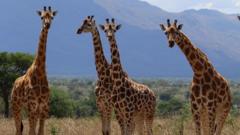Giraffes have long captured the fascination of the public, often regarded as emblematic of the African savanna. While traditionally classified under a single species, new research from the International Union for Conservation of Nature (IUCN) has challenged this notion, identifying three additional species of giraffe than previously acknowledged. This new classification not only sheds light on the genetic diversity of these majestic mammals but also has implications for their conservation.
Through comparative studies focusing on the skull size and head shape of different giraffe populations, scientists have established significant genetic variation that justifies recognizing four distinct species. Historical separation attributed to Africa’s natural features—including deserts, rivers, and forests—played a crucial role in the divergent evolution of these groups.
The first newly acknowledged species is the Southern giraffe, which resides in regions such as South Africa, Angola, and southern parts of Namibia and Zimbabwe. Natural barriers like the Kunene and Zambezi rivers, along with the Congo Basin’s rainforests, were key in isolating these animals from others.
Next is the Reticulated giraffe, primarily found in Kenya, Somalia, and Ethiopia. It has adapted to the savannas and grasslands of its native habitat, with physical separations caused by the Tana River and adjacent mountains disrupting potential interbreeding with other populations.
The Northern giraffe follows, occupying areas in western Ethiopia, central Kenya, and eastern South Sudan. Migration paths, influenced by bodies such as the Nile River and Lake Victoria, have maintained its isolation from the other giraffe species.
Lastly, the Masai giraffe is notable for its unique leaf-patterned coat and a range that spans Kenya, Tanzania, and Uganda. Although visually distinct, researchers emphasize that variation within a single population's patterns may not signal separate species.
The IUCN emphasizes that recognizing these genetic differences is crucial for developing effective conservation strategies. Previously classified solely as vulnerable, the re-evaluation of each of these species will help tailor protection measures for their survival. As the IUCN prepares to assess the conservation status of these species in detail, the hope is to secure a brighter future for the world's tallest mammals.























